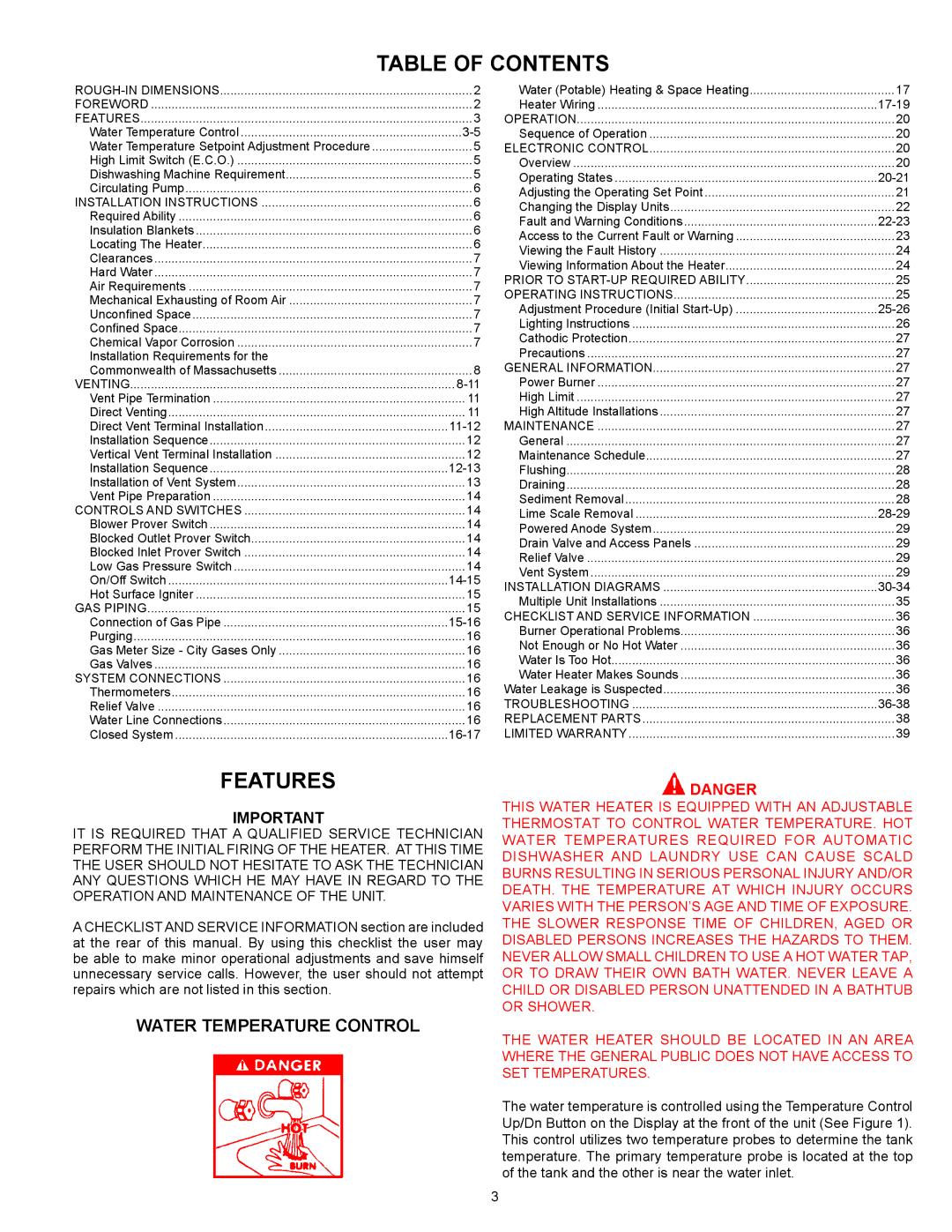
TABLE OF CONTENTS
2 | |
FOREWORD | 2 |
FEATURES | 3 |
Water Temperature Control | |
Water Temperature Setpoint Adjustment Procedure | 5 |
High Limit Switch (E.C.O.) | 5 |
Dishwashing Machine Requirement | 5 |
Circulating Pump | 6 |
INSTALLATION INSTRUCTIONS | 6 |
Required Ability | 6 |
Insulation Blankets | 6 |
Locating The Heater | 6 |
Clearances | 7 |
Hard Water | 7 |
Air Requirements | 7 |
Mechanical Exhausting of Room Air | 7 |
Unconfined Space | 7 |
Confined Space | 7 |
Chemical Vapor Corrosion | 7 |
Installation Requirements for the |
|
Commonwealth of Massachusetts | 8 |
VENTING | |
Vent Pipe Termination | 11 |
Direct Venting | 11 |
Direct Vent Terminal Installation | |
Installation Sequence | 12 |
Vertical Vent Terminal Installation | 12 |
Installation Sequence | |
Installation of Vent System | 13 |
Vent Pipe Preparation | 14 |
CONTROLS AND SWITCHES | 14 |
Blower Prover Switch | 14 |
Blocked Outlet Prover Switch | 14 |
Blocked Inlet Prover Switch | 14 |
Low Gas Pressure Switch | 14 |
On/Off Switch | |
Hot Surface Igniter | 15 |
GAS PIPING | 15 |
Connection of Gas Pipe | |
Purging | 16 |
Gas Meter Size - City Gases Only | 16 |
Gas Valves | 16 |
SYSTEM CONNECTIONS | 16 |
Thermometers | 16 |
Relief Valve | 16 |
Water Line Connections | 16 |
Closed System |
Water (Potable) Heating & Space Heating. | ......................................... 17 |
Heater Wiring | |
OPERATION | 20 |
Sequence of Operation | 20 |
ELECTRONIC CONTROL | 20 |
Overview | 20 |
Operating States | |
Adjusting the Operating Set Point | 21 |
Changing the Display Units | 22 |
Fault and Warning Conditions | |
Access to the Current Fault or Warning | 23 |
Viewing the Fault History | 24 |
Viewing Information About the Heater | 24 |
PRIOR TO | 25 |
OPERATING INSTRUCTIONS | 25 |
Adjustment Procedure (Initial | |
Lighting Instructions | 26 |
Cathodic Protection | 27 |
Precautions | 27 |
GENERAL INFORMATION | 27 |
Power Burner | 27 |
High Limit | 27 |
High Altitude Installations | 27 |
MAINTENANCE | 27 |
General | 27 |
Maintenance Schedule | 27 |
Flushing | 28 |
Draining | 28 |
Sediment Removal | 28 |
Lime Scale Removal | |
Powered Anode System | 29 |
Drain Valve and Access Panels | 29 |
Relief Valve | 29 |
Vent System | 29 |
INSTALLATION DIAGRAMS | |
Multiple Unit Installations | 35 |
CHECKLIST AND SERVICE INFORMATION | 36 |
Burner Operational Problems | 36 |
Not Enough or No Hot Water | 36 |
Water Is Too Hot | 36 |
Water Heater Makes Sounds | 36 |
Water Leakage is Suspected | 36 |
TROUBLESHOOTING | |
REPLACEMENT PARTS | 38 |
LIMITED WARRANTY | 39 |
FEATURES
IMPORTANT
IT IS REQUIRED THAT A QUALIFIED SERVICE TECHNICIAN PERFORM THE INITIAL FIRING OF THE HEATER. AT THIS TIME THE USER SHOULD NOT HESITATE TO ASK THE TECHNICIAN ANY QUESTIONS WHICH HE MAY HAVE IN REGARD TO THE OPERATION AND MAINTENANCE OF THE UNIT.
A CHECKLIST AND SERVICE INFORMATION section are included at the rear of this manual. By using this checklist the user may be able to make minor operational adjustments and save himself unnecessary service calls. However, the user should not attempt repairs which are not listed in this section.
WATER TEMPERATURE CONTROL
![]() DANGER
DANGER
THIS WATER HEATER IS EQUIPPED WITH AN ADJUSTABLE THERMOSTAT TO CONTROL WATER TEMPERATURE. HOT WATER TEMPERATURES REQUIRED FOR AUTOMATIC DISHWASHER AND LAUNDRY USE CAN CAUSE SCALD BURNS RESULTING IN SERIOUS PERSONAL INJURY AND/OR DEATH. THE TEMPERATURE AT WHICH INJURY OCCURS VARIES WITH THE PERSON’S AGE AND TIME OF EXPOSURE. THE SLOWER RESPONSE TIME OF CHILDREN, AGED OR DISABLED PERSONS INCREASES THE HAZARDS TO THEM. NEVER ALLOW SMALL CHILDREN TO USE A HOT WATER TAP, OR TO DRAW THEIR OWN BATH WATER. NEVER LEAVE A CHILD OR DISABLED PERSON UNATTENDED IN A BATHTUB OR SHOWER.
THE WATER HEATER SHOULD BE LOCATED IN AN AREA WHERE THE GENERAL PUBLIC DOES NOT HAVE ACCESS TO
SET TEMPERATURES.
The water temperature is controlled using the Temperature Control Up/Dn Button on the Display at the front of the unit (See Figure 1). This control utilizes two temperature probes to determine the tank temperature. The primary temperature probe is located at the top of the tank and the other is near the water inlet.
